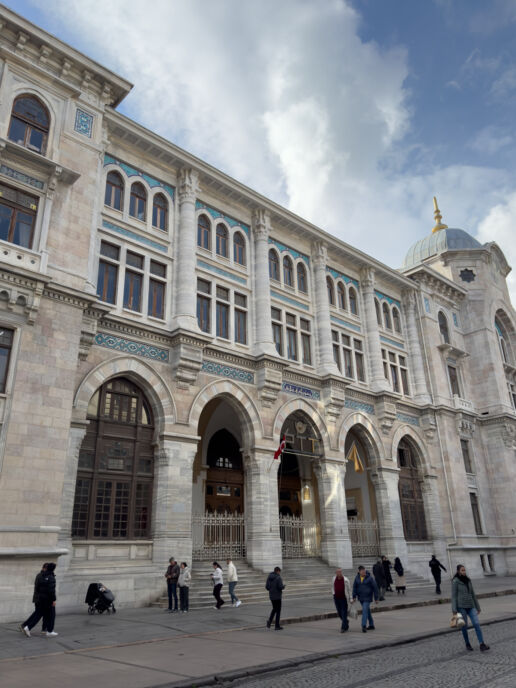A REPUBLICAN ERA ARCHITECT: VEDAD TEK
As the Republic of Turkey celebrates its centenary, we rely on our architectural history to look back and remember when the Republic was proclaimed. This is an homage to Vedad Tek, one of the leading architects of his time and a pioneer of the First National Architecture Movement.
THE VEDAD TEK HOUSE
Anyone who has lived in Istanbul’s Nişantaşı neighbourhood or goes there frequently will be able to point out the famous Vedad Tek House at the intersection of Valikonağı Boulevard and Süleyman Nazif Street. Designed as a home for the architect and his family, the building was completed in 1914. Adorned with eclectic trim and tiles on its façade it stands out from the surrounding buildings, undoubtedly one of the best examples of the First National Architecture Movement and a summary of Vedad Tek’s architectural language. The recent reopening of the famous Zihni Bar in this house brings back many memories for me. Some people might also remember that Yekta restaurant, named after Vedad Tek’s daughter Selime Yekta Işıtan, occupied the ground floor of the building for years. Nowadays, the German Beer House stands in Yekta’s place.
Vedad Tek was born in Beşiktaş, Istanbul in 1873, the son of Sırrı Pasha, a statesman who held important positions in the Ottoman government. Coming from an aristocratic family, Tek attended the best schools and enjoyed the benefits of his privileges into his teens. He had become a well-respected architect by the early 1920s, which also allowed him to work with Atatürk. (Details about Ataturk and Tek’s professional relationship are vague. There are rumours of occasional disagreements, but a lack of sound evidence makes it hard to establish facts.)
THE GRAND POST OFFICE BUILDING
The Post and Telegraph Administration building in Sirkeci (now the Grand Post Office) represented a significant turning point in Tek’s architectural career. This building is the embodiment of its name and function. In the final years of the Ottoman Empire, Sultan Abdülhamit had the prescience to promote new communications technologies. He decided to combine postal and telegraph operations under a single roof and appointed Vedad Tek to design a new building. Measuring approximately 90m by 40m, this monumental edifice is a classic example of late Ottoman architecture. Its construction began on the day of the Sultan’s accession to the throne on September 1, 1903 and took five years to complete. Even today, it is the most imposing building in Sirkeci. During the same period, Tek also restored and added onto the ruined Hobyar Mosque (1437), creating a building that is equally magnificent.
The construction of the Defter-i Hakani (Title Deed Registry and Archives) building in Sultanahmet Square started soon after the completion of the post office. Tek used the model he developed for the Kastamonu Town Hall for this new building. Now repurposed as a museum, it stands out for its early use of reinforced concrete.
THE REPUBLICAN PERIOD
Architect Tek was invited to Ankara during the Republican period, where he renovated Atatürk’s residence and directed the construction of the Second Parliament building. He was simultaneously engaged in the design of the Ankara Palas Hotel, but the project was shelved due to disagreements, after which Tek returned to Istanbul. It is possible that this rupture marked the end of his ties with Atatürk.
NİŞANTAŞI FLATS
His zeal for the Republican movement and its leaders may have been short-lived, but Tek remains one of the leading lights of Republican-era architecture.He is particularly recognised for the simplicity of his Art Deco details. When his work in Ankara dried up, Tek resumed housing projects around Nişantaşı and began to lecture at the Sanayi-i Nefise Mektebi (School of Fine Arts). He continued to innovate the use of reinforced concrete in construction and designed several apartment buildings, such as the Yayla Apartment in Nişantaşı, which, sadly, are no longer standing. Among his projects, one of the precious survivors is the Art Deco Sinanağa Flats in Çemberlitaş, built in 1934.
Tek died in Istanbul in 1942 from complications related to diabetes and was buried in Edirnekapı Martyr’s Cemetery. His son Nihad Vedad Tek also went on to become an accomplished architect. The country would be wise to preserve the legacy of both men.
Source: https://ataturkansiklopedisi.gov.tr/bilgi/mimar-mehmed-vedad-tek-1873-1942/







